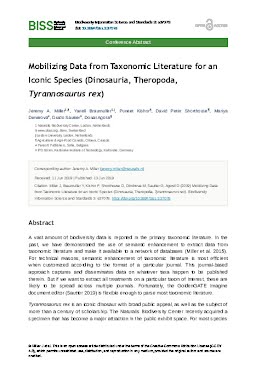2019-06-13
Mobilizing Data from Taxonomic Literature for an Iconic Species (Dinosauria, Theropoda, Tyrannosaurus rex)
Publication
Publication
A vast amount of biodiversity data is reported in the primary taxonomic literature. In the past, we have demonstrated the use of semantic enhancement to extract data from taxonomic literature and make it available to a network of databases (Miller et al. 2015). For technical reasons, semantic enhancement of taxonomic literature is most efficient when customized according to the format of a particular journal. This journal-based approach captures and disseminates data on whatever taxa happen to be published therein. But if we want to extract all treatments on a particular taxon of interest, these are likely to be spread across multiple journals. Fortunately, the GoldenGATE Imagine document editor (Sautter 2019) is flexible enough to parse most taxonomic literature. Tyrannosaurus rex is an iconic dinosaur with broad public appeal, as well as the subject of more than a century of scholarship. The Naturalis Biodiversity Center recently acquired a specimen that has become a major attraction in the public exhibit space. For most species on earth, the primary taxonomic literature contains nearly everything that is known about it. Every described species on earth is the subject of one or more taxonomic treatments. A taxon-based approach to semantic enhancement can mobilize all this knowledge using the network of databases and resources that comprise the modern biodiversity informatics infrastructure. When a particular species is of special interest, a taxon-based approach to semantic enhancement can be a powerful tool for scholarship and communication. In light of this, we resolved to semantically enhance all taxonomic treatments on T. rex. Our objective was to make these treatments and associated data available for the broad range of stakeholders who might have an interest in this animal, including professional paleontologists, the curious public, and museum exhibits and public communications personnel. Among the routine parsing and data sharing activities in the Plazi workflow (Agosti and Egloff 2009), taxonomic treatments, as well as cited figures, are deposited in the Biodiversity Literature Repository (BLR), and occurrence records are shared with the Global Biodiversity Information Facility (GBIF). Treatment citations were enhanced with hyperlinks to the cited treatment on TreatmentBank, and specimen citations were linked to their entries on public facing collections databases. We used the OpenBiodiv biodiversity knowledge graph (Senderov et al. 2017) to discover other taxa mentioned together with T. rex, and to create a timeline of T. rex research to evaluate the impact of individual researchers and specimen repositories to T. rex research. We contributed treatment links to WikiData, and queried WikiData to discover identifiers to different platforms holding data about T. rex. We used bloodhound-tracker.net to disambiguate human agents, like collectors, identifiers, and authors. We evaluate the adequacy of the fields currently available to extract data from taxonomic treatments, and make recommendations for future standards.
| Additional Metadata | |
|---|---|
| Pensoft Publishers | |
| doi.org/10.3897/biss.3.37078 | |
| Biodiversity Information Science and Standards | |
| released under the Creative Commons Attribution License (CC BY 4.0) | |
| Organisation | Staff publications |
|
Miller, J., Braumuller, Y., K.P. Kishor, D. Shorthouse, M. Dimitrova, Sautter, G., & D. Agosti. (2019). Mobilizing Data from Taxonomic Literature for an Iconic Species (Dinosauria, Theropoda, Tyrannosaurus rex). Biodiversity Information Science and Standards, 3. doi:10.3897/biss.3.37078 |
|
